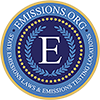Emission testing is a vital part of ensuring our vehicles are environmentally responsible and compliant with local regulations.
However, it’s essential to recognize that emission testing isn’t a one-size-fits-all process. The protocols and requirements can vary significantly from state to state.
In this comprehensive guide, we will delve into the specifics of emission testing in two states, Colorado and Maryland, shedding light on their unique features.
Understanding these variations is crucial for vehicle owners in these regions to maintain compliance and reduce their environmental footprint.

Emission Testing in Colorado
Colorado is committed to addressing air quality concerns, especially in urban areas where pollution is a significant issue. Their emission testing program is robust, aiming to curtail harmful emissions and enhance overall air quality. Here’s a detailed look at Colorado’s emission testing procedures.
- Tailpipe Emissions: In Colorado, a key facet of emission testing involves evaluating tailpipe emissions, including pollutants like carbon monoxide (CO), nitrogen oxides (NOx), and hydrocarbons (HC). This scrutiny helps pinpoint vehicles potentially contributing to air pollution.
- Onboard Diagnostics (OBD): Colorado enforces Onboard Diagnostics (OBD) testing for vehicles equipped with this system. OBD testing verifies the proper operation of a vehicle’s emission control systems, a crucial step in ensuring compliance with emission standards.
- Exemptions: In Colorado, despite stringent emission testing requirements, certain regions, particularly rural areas with better air quality, are exempt from these tests. These exemptions aim to strike a balance between environmental protection and practicality.
Emission Testing in Maryland
Maryland shares a commitment to controlling vehicle emissions, and its procedures are designed to achieve this goal effectively. Here’s an insight into Maryland’s emission testing protocols.
- Tailpipe Emissions: Maryland conducts comprehensive tailpipe emissions tests, measuring gases and particles emitted from a vehicle’s exhaust system. These tests serve to identify vehicles potentially contributing to air pollution.
- Two-Speed Idle Test: Maryland utilizes a two-speed idle test for older vehicles, assessing emissions at both idle and higher speeds for a comprehensive evaluation. This test is commonly applied to older vehicles to confirm compliance with emission standards.
- On-Road Emissions Testing: Maryland takes an innovative approach by conducting on-road emissions testing for select vehicles. This method assesses emissions while vehicles are in motion, ensuring compliance with standards under real-world driving conditions.
- Emissions Repair Waivers: In certain instances, vehicles that fail the initial emissions test may qualify for emissions repair waivers, subject to specific criteria. These waivers enable vehicle owners to systematically address emissions-related issues.
Key Differences Between Colorado and Maryland Emission Testing
In this section, we will carefully investigate the essential variations in emission testing protocols between Colorado and Maryland, providing detailed insights into their distinct approaches to ensuring vehicle emissions compliance.
Testing Methods
Let us examine the varied testing methods utilized by Colorado and Maryland in their emission testing programs. We will emphasize significant differences in their approaches, offering a comprehensive understanding of their respective protocols.
- Colorado: Colorado’s emission testing prominently features Onboard Diagnostics (OBD) testing, alongside tailpipe emissions testing. OBD testing is used to ensure a vehicle’s emission control systems are operating correctly.
- Maryland: Maryland employs a diverse approach to testing. In addition to tailpipe emissions testing, it uses a two-speed idle test for older vehicles. Furthermore, Maryland conducts on-road emissions testing for specific vehicles, assessing emissions while they are in motion.
Exemptions
In this section, we’ll delve into the exemptions offered by Colorado and Maryland in their emission testing programs, shedding light on the criteria and regional variations that impact vehicle owners.
- Colorado: Some areas in Colorado, particularly those with cleaner air quality, are exempt from emission testing. These exemptions are designed to strike a balance between environmental protection and practicality.
- Maryland: Instead of exemptions, Maryland offers emissions repair waivers. This means that if a vehicle fails the initial emissions test but meets specific criteria, it may qualify for a waiver. This approach allows vehicle owners to systematically address emissions issues.
Regulations
Discover the regulatory landscape of emission testing in Colorado and Maryland. We’ll uncover how these states maintain strict standards while adapting to regional air quality concerns and unique requirements.
- Both Colorado and Maryland have stringent emissions regulations in place. However, the specific standards and requirements can vary between the two states. These variations are influenced by regional air quality concerns and regulatory factors.
OBD (Onboard Diagnostics) Testing in Colorado
The criteria for OBD testing ensure that vehicles equipped with this system comply with emission control standards by verifying the proper functioning of their emission control systems. These criteria encompass specific parameters and procedures that technicians follow during the testing process.
- Verification of Emission Control Systems: OBD testing checks emission control systems, like catalytic converters, for pollutants. States set parameters for emissions and sensor function.
- Specific Parameters: Technicians use diagnostic equipment to read error codes from the vehicle’s onboard computer. Codes reveal emission system issues.
- Error Code Analysis: If error codes signal problems, additional diagnostics may be needed for repair and maintenance.
- Real-time Monitoring: OBD systems monitor emission components and generate error codes for malfunctions, triggering dashboard warning lights.
- Efficiency Assessment: OBD testing evaluates both functionality and efficiency of emission control systems, vital for compliance.
- Consistency and Standardization: Standardized OBD testing ensures equitable evaluation for all equipped vehicles, ensuring fairness in the testing process.
The Two-Speed Idle Test in Maryland
This test assesses the emissions performance of these vehicles under different engine operating conditions, specifically at idle and higher speeds. The criteria for the Two-Speed Idle Test are designed to comprehensively evaluate the emissions generated by these vehicles.
- Emissions Evaluation: Two-Speed Idle Test evaluates emissions from older vehicles, measuring pollutants like CO, HC, and NOx at idle and higher speeds.
- Comprehensive Assessment: Comprehensive testing assesses emissions under various driving conditions, providing a realistic view of vehicle behavior.
- Age-Related Considerations: Criteria consider emission profiles of older vehicles, setting standards accordingly.
- Regulatory Standards: Regulatory standards guide Two-Speed Idle Test criteria, ensuring compliance with emission thresholds.
- Data Collection: Test collects emissions data, including pollutant measurements and engine speed.
- Pass/Fail Determination: Pass or fail determination based on emissions data, encouraging proactive maintenance for older vehicles to meet standards.
- Maintenance Implications: Understanding Two-Speed Idle Test criteria promotes proactive maintenance in older vehicles to meet emission standards and reduce the likelihood of failure.
Impact on Vehicle Owners
Understanding the disparities in emission testing protocols among states can profoundly influence vehicle owners. This section will delve into the specific ways these variations impact vehicle owners, providing valuable insights into the consequences of regional differences in testing procedures.
Cost of Compliance
Understand the financial aspects of emission testing compliance in Colorado and Maryland, including varying costs based on location and testing methods, ensuring you’re prepared for the expenses.
- Colorado: Compliance costs in Colorado can vary depending on your location within the state. Some areas may be exempt from testing, reducing the cost for vehicle owners. However, OBD testing may have associated fees.
- Maryland: In Maryland, emissions testing fees apply uniformly across the state. Vehicle owners should budget for these fees, which can vary based on the type of test their vehicle undergoes.
Frequency of Testing
Discover the variances in testing frequency between Colorado and Maryland, offering valuable insights into the required frequency for emissions testing to ensure compliance with state regulations. This information is essential for vehicle owners to stay in line with testing schedules.
- Colorado: The frequency of emissions testing in Colorado can differ depending on your location within the state. Some areas may require testing every two years, while others may have less frequent requirements.
- Maryland: Maryland maintains consistent emissions testing frequency, with a majority of vehicles undergoing testing every two years. This uniformity simplifies the testing schedule for vehicle owners across the state.
Environmental Impact
Emission testing significantly impacts your vehicle’s environmental footprint in both Colorado and Maryland. Understanding this influence empowers you to make informed decisions that contribute to cleaner air in your region.
- Colorado: Colorado’s testing protocols aim to reduce harmful emissions, contributing to cleaner air. Understanding the state’s specific testing criteria empowers vehicle owners to play their part in minimizing environmental impact.
- Maryland: Maryland’s emissions testing procedures also contribute to cleaner air quality. Vehicle owners who are informed about the state’s testing criteria can make eco-conscious choices to reduce their environmental footprint.
Maintenance
Discover how understanding the specific tests your vehicle undergoes in Colorado and Maryland can encourage proactive maintenance, potentially saving you money in the long run on repairs and upkeep.
- Colorado: Being aware of Colorado’s testing methods, which include OBD testing, helps vehicle owners stay proactive about maintenance. Detecting and addressing emission control system issues promptly can lead to cost savings in the long run.
- Maryland: Maryland’s comprehensive testing, including tailpipe and two-speed idle tests, provides a holistic view of a vehicle’s emissions. This encourages vehicle owners to keep their vehicles well-maintained, potentially reducing future repair costs.
Comprehending the variances in emission testing between Colorado and Maryland holds significance not just for compliance but also for reducing your vehicle’s environmental footprint. Both states have customized their protocols to address local air quality and regulations.
For vehicle owners, knowledge and proactivity are paramount. Familiarity with your state’s testing criteria, exemptions, and regulations empowers you to make eco-conscious choices concerning your vehicle’s compliance and environmental influence.
Empower Your Emissions Journey
Why leave your vehicle’s emissions destiny to chance when you can take control and drive towards a greener, more sustainable future? At Emissions.org, we’re committed to helping you navigate the complexities of emission testing and vehicle compliance.
Our team specializes in optimizing your emissions performance and boosting your revenue with an efficient sales team. Don’t wait—take control of your vehicle’s emissions destiny and reach out to us now. Contact us today to learn how we can assist you on your journey to a greener, more sustainable future.

No comment yet, add your voice below!